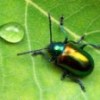Although this paper is several years old, I still read through it for a good laugh now and again. It's a bold attempt by Aussie myrmecologist Alan Andersen to remedy the dearth of ant common names. Hilarity ensues.
As we know, ants are too small and too numerous for most species to have caught the attention of the broader human populace. Few species have ever acquired a vernacular name, in any language, and biologists are generally happy to use the formal Latin nomenclature.
Andersen's hallucinogenic trip through the myrmecofauna is worth a read, though. I doubt most of the names will stick- for the same reason that the ants lacked common names in the first place- but I don't fault him for trying.
I do hope to work someday on Topless Cannibal Ants. It'd make great cocktail party conversation.




Wouldn't Topless Cannibal Ants be like that headless ant you found in Florida a while back?
It _does_ look a bit like Snugglepot.
Did anyone else see an ant covered with body paint and roasting ant parts on a spit? Ok, maybe it's just me.
Oops, accidentally responded with this at the contest thread, but here goes again:
Sad that all the parrot ants will now have to be called highlander ants. :(
As much as I like Alan, and his sense of humour, he seems to have been serious here. Bah humbug! I strongly disagree with the push towards 'approved' common names as redundant, ridiculous, pompous, and bluenosed (and I don't mean the southern black bream).
I know that standard common names can be important for commercial species (a friend on the fish name committee convinced me of that), but people should be free to call a bug whatever they want and if they need to be specific, they can use the Latin binomial. I don't think that standard common names will do anything to get the public to like ants any better, but I must admit that I find Topless Cannibal Ant somewhat prurient and frightening. Is there a website?
Sure, there's a website: http://www.terc.csiro.au/antnames.asp
Thanks David - I can hardly wait to make-up the common names for their ant mites.